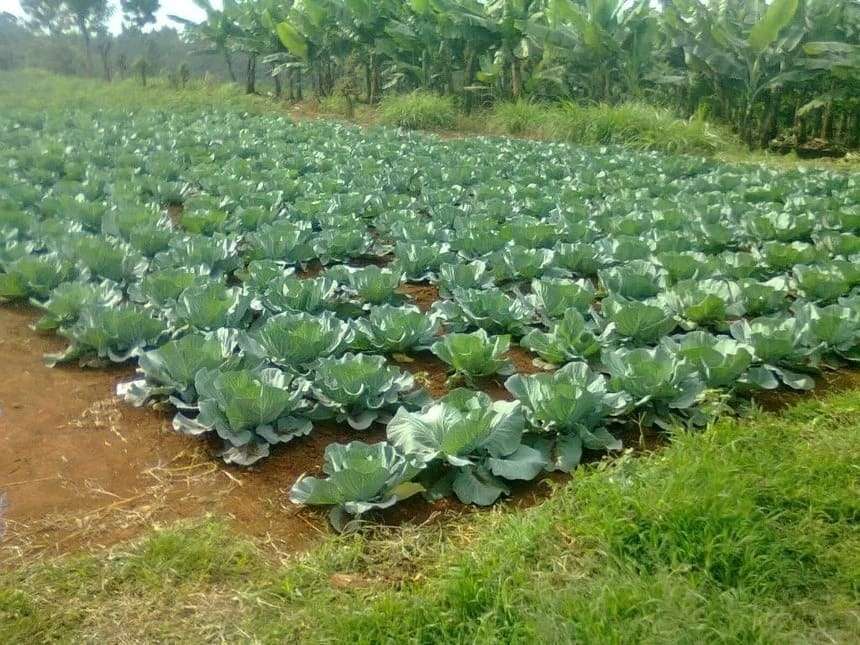Cabbage farming originated in Europe and is today widely grown in many parts of East Africa for its leaves. Secondly, cabbage has a close relationship with other crops such as Kale, Cauliflower, Celery Cabbage, and Chinese Cabbage.
Ecological requirements of cabbage farming.
- Rainfall: It needs annual rainfall of 200mm. However, an average amount of 750mm p.a, that is well distributed throughout the growing season.
- Altitude and Temperature: Cabbage grows well at temperatures of 13-21°C. However, in a hot climate, head formation never happens. It flowers in very low temperatures.
- Soils: Cabbage grows well in deep, fertile, well-drained soils which are slightly acidic. Therefore, a Soil pH of 5.5-6.5 becomes the most suitable.
Varieties of Cabbage.

- Early Maturing Varieties: The type matures in 2months. These include Sugarloaf and O.S.crows among others.
- Mid-season Varieties: mature in 3months. They are Prize drumhead, Copenhagen market, and Large Late Drumhead.
- Late Maturing Varieties: They mature in 4 or more months. They include Early stone head, Savoy perfection, Dwarf Flat Dutch, and Mammoth Red Rock.
Nursery establishment.
Cabbage seeds should be first raised in the nursery. Therefore, u should prepare a nursery bed by first clearing the land. Secondly, harrow to fine tilth and level the seedbed. Thirdly, make drills with a spacing of 10cm apart. Nonetheless sow seeds along with the drills and cover with a thin layer of soil.
Fields operations for cabbage farming.
- Land Preparation: The seedbed should be prepared during the dry season. Plowed deeply and eradicate all the weeds.
- Transplanting: Transplant when the seedlings take place when 10-15cm in height or one month after germination.
- Fertilizer Application: Topdress with one tablespoonful of C.A.N or Sulphate of ammonia per plant.
- Weeding: carry out shallow weeding using hand tools such as jembes.
Pest and disease control.
- Cabbage Aphid: These are pests that attack cabbage leaves. Therefore, one should spray with Diazinon or Dimethoate.
- Cutworms: They cut the seedlings’ stem at the base. Control them by dusting lightly the base of each seedling during transplanting with dieldrin.
- Cabbage Sawfly: These pests eat the leaves often leaving only the midrib. Therefore, control them by spraying with Fenvalerate.
- Ringspot: It is mainly spread by wind or compost made from infected material. Therefore, controlled by crop rotation and the planting of healthy seedlings.
Harvesting and marketing.
Harvest when the heads become firm and solid. Nonetheless, pick the sprouts from the bottom of the plant. Cut the solid head at the base attached to the stem using a sharp knife. The produce is sold in urban centers, greengrocers, and big hotels.
- Len Goodman Bio, Education, Career, Family, Net Worth
- Chris Paul Bio-Age, Wife, Children, Career, Net Worth.
- Amanda Ruiz Bio, Wiki, Age, KTBC -7, Education, Family, Children, Husband, Net Worth
- Who is Mwangi Kiunjuri, family, and politics?
- Jane Lonsdale bio-age, KTBC-TV, children, husband, net worth.
- Lady Justice Martha koome Age, Education, Career.
- Who is Kristi Noem, her age, husband, children, religion, politics?
- The best private primary schools in Nyeri county.
- How is The Lenana Boy school and location?
- Best Public High Schools in Kiambu County.
- What is the history of Kenyatta University?
- Mount Kenya University history, fees, courses
- Egerton university, fees, location, courses.
- A list of special secondary schools, and contacts.